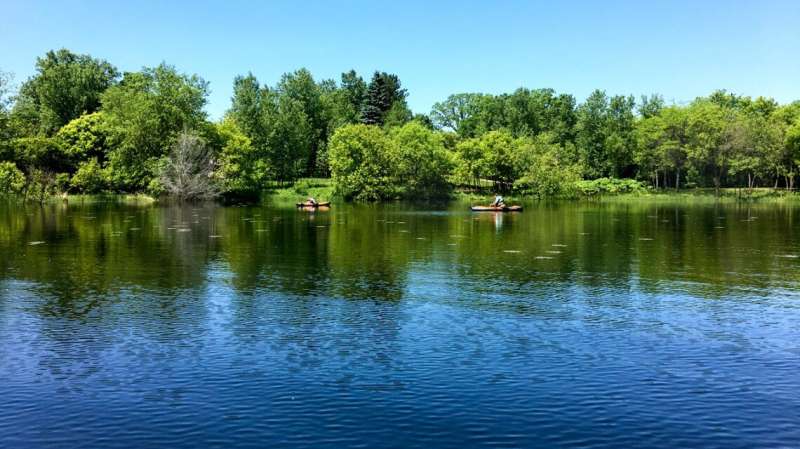This article has been reviewed according to Science X's editorial process and policies. Editors have highlighted the following attributes while ensuring the content's credibility:
fact-checked
trusted source
proofread
Pond emission measurements improve climate predictions

There could be billions of shallow lakes and ponds on Earth, though lack of mapping systems makes it hard to know just how many exist. Together, they emit significant amounts of greenhouse gases into the atmosphere, but emissions from these systems vary considerably and are not well understood.
Now, a new study measures methane and carbon dioxide emissions from 30 small lakes and ponds (one acre or less) in temperate areas of Europe and North America, revealing that the smallest and shallowest bodies of water exhibit the greatest variability over time.
The paper marks an important step toward calibrating climate models so they better predict emissions from inland waterbodies and it points to the need to study small waterbodies more closely.
"This study helps understand both the drivers of greenhouse gas concentrations, and importantly, what makes some ponds more variable in their concentrations," said Meredith Holgerson, assistant professor of ecology and evolutionary biology in the College of Agriculture and Life Sciences and senior author of the study.
"The paper points to patterns across a broad geographic range, such that we can actually get in and predict which waterbodies are going to vary and will be most variable, and it confirms that we need to go out and sample frequently," said Nicholas Ray, a postdoctoral researcher in Holgerson's lab, and first author of the paper, "Spatial and Temporal Variability in Summertime Dissolved Carbon Dioxide and Methane in Temperate Ponds and Shallow Lakes," which published online May 18 in the journal Limnology and Oceanography.
Holgerson and colleagues have previously estimated that shallow lakes and ponds may contribute 5% of the global methane emissions to the atmosphere. But without accurate measurements across many water bodies, they said, the true number could be as little as half or as much as twice that percentage.
While some small lakes and ponds emit greenhouse gasses in consistent, predictable amounts, others are highly variable. Some ponds emit large amounts, and others emit very little. Understanding these dynamics is important as carbon dioxide and methane act as greenhouse gases in the atmosphere, with methane being 25 times more potent at trapping heat than carbon dioxide.
To begin, Holgerson and collaborators at the Global Lake Ecological Observatory Network designed the study and then reached out farther afield within the network. Sampling supplies were mailed to 16 study co-authors scattered across Europe and North America, who then collected gas samples from a total of 30 small and shallow ponds and lakes, which were analyzed.
Each body of water was sampled over the 2018 and 2019 summers at three times in three locations, including the deepest point and then two locations on opposite ends (but not too close to the shore).
"One key result we found was that the smaller the system is, in regards to surface area, the higher emissions are likely to be," Ray said.
For carbon dioxide, samples were consistent in all parts of the waterbody, which revealed that researchers likely only needed to collect a sample from one location to get an accurate prediction of the whole body of water. Methane, on the other hand, required samples from multiple locations to get an accurate measure. Also, for methane, shallower systems were more variable, suggesting stratification of the water column in deeper water may prevent gases from rising to the surface.
Similarly, in terms of timing, a single sample in the summer provided a reasonably accurate carbon dioxide reading for the entire summer, but an accurate average emission rate of methane required multiple samplings over the course of the summer.
For carbon dioxide, the amount of plant life in the water played a large role in variability over time. For methane, variability was more driven by the water depth and likely associated with stratification in the water column.
Among other uses, the study sets the groundwork for informing a New York state climate mitigation strategy to build more ponds to help farmers better handle droughts.
"We're working to identify how ponds can be built, or if there are simple management strategies people can employ, to minimize emissions," Ray said.
More information: Nicholas E. Ray et al, Spatial and temporal variability in summertime dissolved carbon dioxide and methane in temperate ponds and shallow lakes, Limnology and Oceanography (2023). DOI: 10.1002/lno.12362
Provided by Cornell University


















